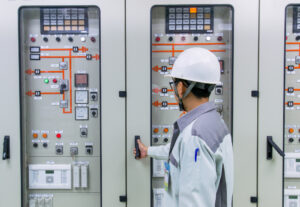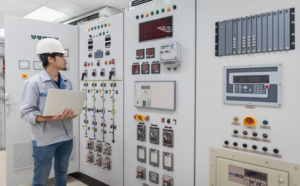Electrical Panels and Its Types | Complete Guide Electrical panels, also known as breaker panels, distribution boards, or electrical switchboards, are critical components of a building’s electrical system.
They serve as the central point for distributing electrical power to various circuits within a structure. Understanding the different types of electrical panels and their functions is essential for ensuring the safety, efficiency, and reliability of an electrical system.
What is an Electrical Panel?
An electrical panel houses circuit breakers or fuses that protect electrical circuits from overloading or short-circuiting. It acts as a distribution point, receiving power from the utility company and directing it to different circuits that power lights, appliances, and outlets throughout a building.
Components of an Electrical Panel
- Main Breaker: Controls the power supply to the entire panel and can shut off all circuits in an emergency.
- Circuit Breakers: Individual switches that control and protect specific circuits. They automatically trip if a circuit becomes overloaded or a short circuit occurs.
- Bus Bars: Metal strips that distribute power from the main breaker to the individual circuit breakers.
- Neutral and Ground Bars: Provide pathways for return currents and a safety path to the ground in case of fault.

Types of Electrical Panels There are several types of electrical panels, each suited to different applications and environments. Here are the most common types:
1. Main Breaker Panel
The main breaker panel is the primary distribution point for electrical circuits in a building. It includes a main breaker that can shut off power to the entire panel. This type is typically used in residential and small commercial buildings.
Features:
- Provides overall protection with a main breaker.
- Distributes power to individual circuit breakers.
- Easy to reset in case of an overload or short circuit.
2. Main Lug Panel
Main lug panels do not have a main breaker. Instead, they rely on a separate disconnect, usually located between the meter and the panel. These panels are often used as sub-panels in larger systems.
Features:
- Lacks a main breaker; requires a separate disconnect.
- Suitable for use as a sub-panel.
- Can be expanded as needed.
3. Sub Panel
A sub panel is an extension of the main panel and is used to distribute power to specific areas of a building, such as a garage, workshop, or additional rooms. It helps manage the load on the main panel and provides more convenient circuit control.
Features:
- Extends the capacity of the main panel.
- Useful for large buildings with multiple power needs.
- Simplifies circuit management in specific areas.
4. Transfer Switch Panel
Transfer switch panels are used in conjunction with backup generators. They allow for the safe transfer of power from the utility grid to a generator during a power outage.
Features:
- Ensures safe and efficient transfer of power to a generator.
- Prevents backfeeding, which can be hazardous to utility workers.
- Can be manual or automatic.

5. Fuse Box
Fuse boxes are an older type of electrical panel that use fuses instead of circuit breakers to protect circuits. While they are still found in some older homes, they are less common in modern installations.
Features:
- Uses fuses that must be replaced if blown.
- Less convenient than circuit breakers.
- Provides basic circuit protection.
Selecting the Right Electrical Panel
Choosing the right electrical panel depends on several factors, including the size of the building, the electrical load, and specific requirements such as backup power. Here are some considerations:
- Capacity: Ensure the panel can handle the total electrical load of the building. Panels are rated by amperage, commonly ranging from 100 to 400 amps for residential use.
- Expansion: Consider future electrical needs. A panel with extra slots for additional breakers can accommodate future expansions.
- Code Compliance: Ensure the panel meets local electrical codes and standards for safety and performance.
- Type of Building: The type of building (residential, commercial, industrial) influences the choice of panel. Industrial settings may require specialized panels with higher capacities and additional safety features.
Installation and Maintenance
Proper installation and regular maintenance of electrical panels are crucial for safety and reliability. Here are some tips:
- Professional Installation: Electrical panels should be installed by a licensed electrician to ensure compliance with codes and standards.
- Regular Inspections: Periodic inspections can identify potential issues such as loose connections, corrosion, or overloaded circuits.
- Upgrades: Older panels, especially fuse boxes, may need to be upgraded to meet modern electrical demands and improve safety.
Conclusion
Understanding the different types of electrical panels and their functions is essential for maintaining a safe and efficient electrical system. Whether for a residential, commercial, or industrial setting, selecting the right panel and ensuring proper installation and maintenance can prevent electrical hazards and ensure reliable power distribution.
Read Also.How to Install a Microwave

